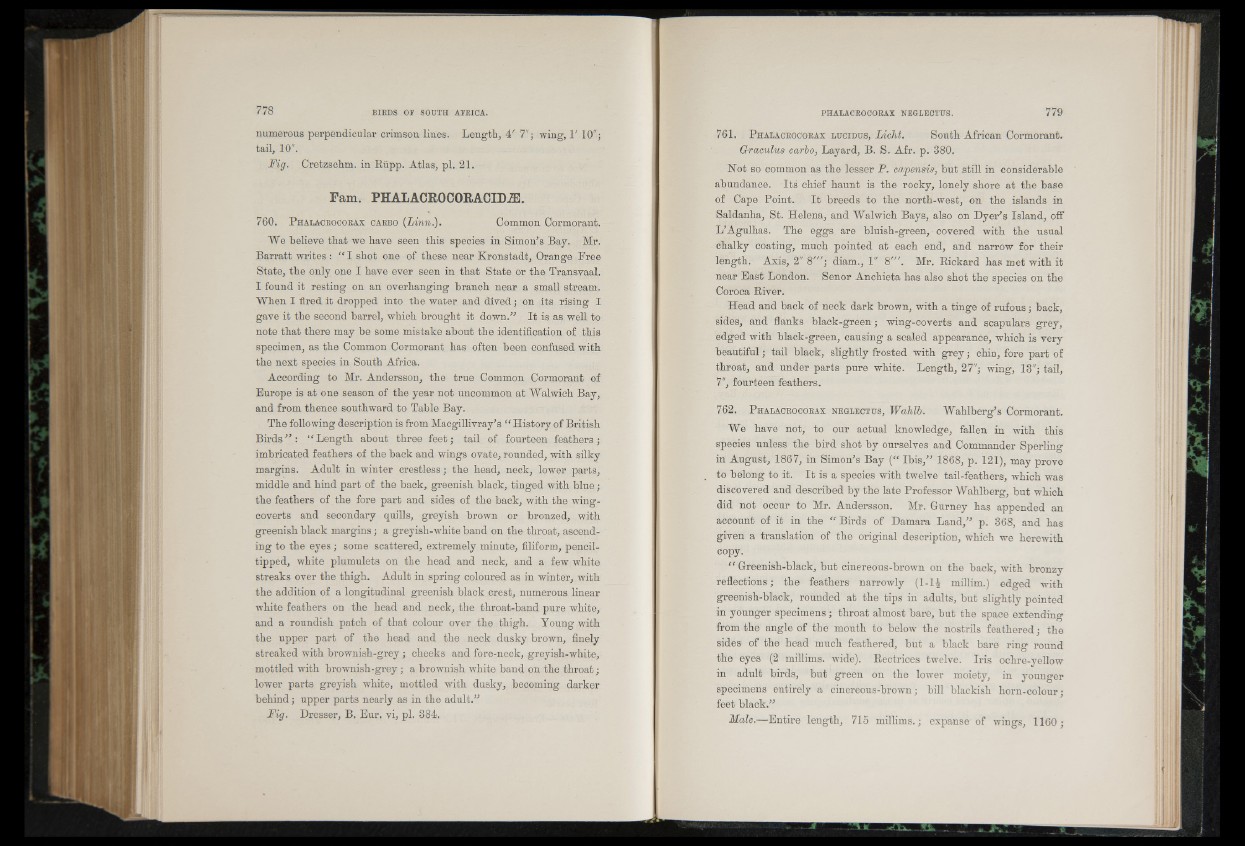
numerous perpendicular crimson lines. Length, V 7"; wing, 1' 10";
tail, 10 ".
Fig. Cretzschm. in Rupp. Atlas, pi. 21.
Fam. PHALACROCORACIDZE.
760. P halacrocorax carbo [Linn.). Common Cormorant.
We believe that we have seen this species in Simon’s Bay. Mr.
Barratt writes : “ I shot one of these near Kronstadt, Orange Free
State, the only one I have ever seen in that State or the Transvaal.
I found it resting on an overhanging branch near a small stream.
When I fired it dropped into the water and dived; on its rising I
gave it the second barrel, which brought it down.” It is as well to
note that there may be some mistake about the identification of this
specimen, as the Common Cormorant has often been confused with
the next species in South Africa.
According to Mr. Andersson, the true Common Cormorant of
Europe is at one season of the year not uncommon at Walwich Bay,
and from thence southward to Table Bay.
The following description is from Macgillivray’s “ History of British
Birds ” : “ Length about three feet; tail of fourteen feathers;
imbricated feathers of the back and wings ovate, rounded, with silky
margins. Adult in winter crestless; the head, neck, lower parts,
middle and hind part of the back, greenish black, tinged with blue;
the feathers of the fore part and sides of the back, with the wing-
coverts and secondary quills, greyish brown or bronzed, with
greenish black margins; a greyish-whiteband on the throat, ascending
to the eyes; some scattered, extremely minute, filiform, pencil-
tipped, white plumulets on the head and neck, and a few white
streaks over the thigh. Adult in spring coloured as in winter, with
the addition of a longitudinal greenish black crest, numerous linear
white feathers on the head and neck, the throat-band pure white,
and a roundish patch of that colour over the thigh. Young with
the upper part of the head and the neck dusky brown, finely
streaked with brownish-grey; cheeks and fore-neck, greyish-white,
mottled with brownish-grey; a brownish white band on the throat;
lower parts greyish white, mottled with dusky, becoming darker
behind; upper parts nearly as in the adult.”
Fig. Dresser, B. Eur. vi, pi. 384.
761. P halacrocorax lucidus, Licht. South African Cormorant.
Graculus carbo, Layard, B. S. Afr. p. 380.
Not so common as the lesser P. ca,pensis, but still in considerable
abundance. Its chief haunt is the rocky, lonely shore at the base
of Cape Point. It breeds to the north-west, on the islands in
Saldanha, St. Helena, and Walwich Bays, also on Dyer’s Island, off
L’Agulhas. The eggs are bluish-green, covered with the usual
chalky coating, much pointed at each end, and narrow for their
length. Axis, 2" 8"'; diam., 1" 8'". Mr. Rickard has met with it
near East London. Senor Anchieta has also shot the species on the
Coroca River.
Head and back of neck dark brown, with a tinge of rufous; back,
sides, and flanks black-green; wing-coverts and scapulars grey,
edged with black-green, causing a scaled appearance, which is very
beautiful; tail black, slightly frosted with grey; chin, fore part of
throat, and under parts pure white. Length, 27"; wing, 13"; tail,
7", fourteen feathers.
762. P halacrocorax neglectus, Wahlb. Wahlberg’s Cormorant.
We have not, to our actual knowledge, fallen in with tbia
species unless the bird shot by ourselves and Commander Sperling
in August, 1867, in Simon’s Bay (“ Ibis,” 1868, p. 121), may prove
to belong to it. It is a species with twelve tail-feathers, which was
discovered and described by the late Professor Wahlberg, but which
did not occur to Mr. Andersson. Mr. Gurney has appended an
account of it in the “ Birds of Damara Land,” p. 368, and has
given a translation of the original description, which we herewith
copy.
“ Greenish-black, but cinereous-brown on the back, with bronzy
reflections; the feathers narrowly (1 - l i millim.) edged with
greenish-black, rounded at the tips in adults, but slightly pointed
in younger specimens; throat almost bare, but the space extending
from the angle of the mouth to below the nostrils feathered; the
sides of the head much feathered, but a black bare ring round
the eyes (2 millims. wide). Rectrices twelve. Iris ochre-yellow
in adult birds, but green on the lower moiety, in younger
specimens entirely a cinereous-brown; bill blackish horn-colour;
feet black.”
Male.—Entire length, 715 millims.; expanse of wings, 1160;